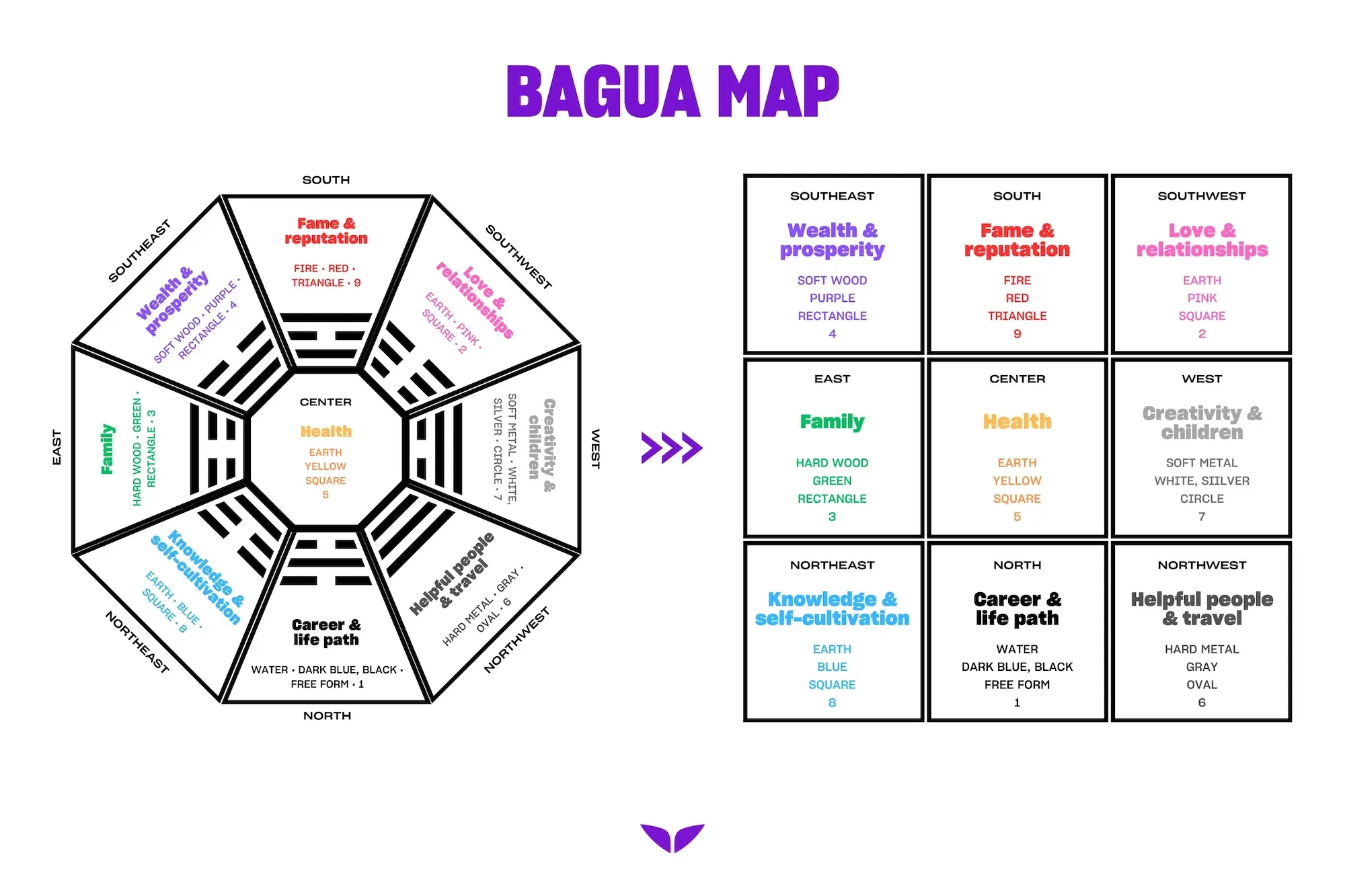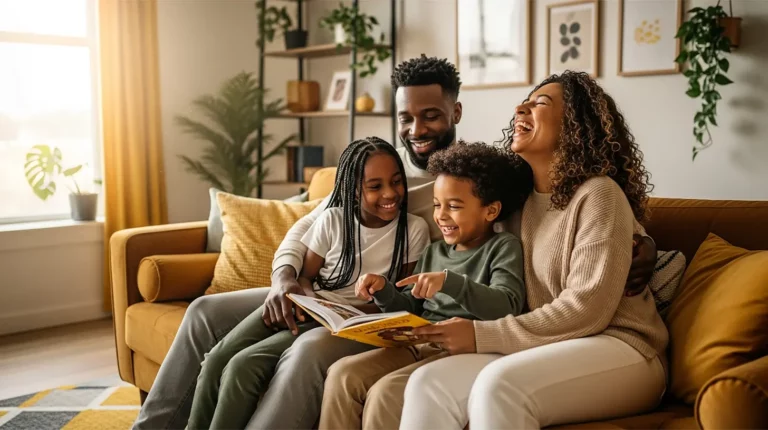Chances are, you’ve heard of feng shui. It’s, as expert Marie Diamond puts it, “about the flow of energy, the flow of qi.”
Now, have you ever heard of a bagua map? This is something that can help you map out your environment so that the qi can flow.
When you understand more about this powerful tool and how to use it, you open the doors for abundance, success, and better relationships to enter your life.
What is the feng shui bagua map?
The bagua map (also called pa kua) is essentially a feng shui tool that shows areas of your home or office that connect to specific areas of your life. And by changing or improving that area of space, you change or improve the corresponding area of your life.
So what’s the purpose of a bagua map? It helps to…
- Enhance beneficial energy,
- Balance positive vibrations,
- Focus intentions,
- Identify and correct subliminal messages, and
- To create a sacred space that nourishes your mind, body, and spirit.
“Everything that is around you affects your subconscious mind,” Marie explains in her Mindvalley Quest, Feng Shui for Life. And using such a powerful tool can do wonders not only for balancing energy but also for bolstering the abundance that comes with the Law of Attraction.
The bagua layout
The tool is typically in the shape of an octagon. However, you may find it as a square with nine equal parts.
Nevertheless, the bagua map has nine sections (the octagon shape has eight sides with the center as the ninth). Each represents a fundamental principle of reality and comes with one of the five elements, as well as colors, shapes, and numbers that can influence the energy in that area.

Center
This represents a balanced life.
- Life area: Health, well-being, balance, vitality
- Element: Earth
- Color: Yellow
- Shape: Square
- Number: 5
South (top middle)
This represents how others perceive you and how they value your contributions. It also corresponds to illumination from within, integrity and honesty.
- Life area: Fame and reputation
- Element: Fire
- Color: Red
- Shape: Triangle
- Number: 9
Southwest (top right)
This represents long-lasting, harmonious relationships built on mutual trust and unconditional love.
- Life area: Love, marriage, relationships
- Element: Earth
- Color: Pink
- Shape: Square
- Number: 2
West (right)
This represents joy, fullness, creativity, and imagination, signifying your relationship with your children.
- Life area: Creativity, children, legacy
- Element: Soft metal
- Color: White, silver
- Shape: Circle
- Number: 7
Northwest (bottom right)
This represents support, guidance, and love from close friends and unseen helpers, and denotes letting go of everything and everyone that doesn’t serve you.
- Life area: Helpful people, compassion, travel
- Element: Hard metal
- Color: Gray
- Shape: Oval
- Number: 6
North (bottom)
This represents career, life purpose, and the flow of life.
- Life area: Self, career, work, journey
- Element: Water
- Color: Dark blue, black
- Shape: Free form
- Number: 1
Northeast (bottom left)
This represents personal strength, wisdom, resourcefulness, self-mastery, and self-control. It’s also the link between a calm and intelligent mind.
- Life area: Skills, knowledge, wisdom, harmony
- Element: Earth
- Color: Blue
- Shape: Square
- Number: 8
East (left)
This represents strong health, loving family relations, honesty, forgiveness, and the foundations for life.
- Life area: Family, health, community
- Element: Hard wood
- Color: Green
- Shape: Rectangle
- Number: 3
Southeast (top left)
This represents happiness, peace, and the ability to take advantage of opportunities.
- Life area: Power, wealth, abundance, and prosperity
- Element: Soft wood
- Color: Purple
- Shape: Rectangle
- Number: 4
What’s more, in Daoist cosmology, the energy map consists of eight trigrams, which are the symbols of the yin and yang energy that’s present in all things. Each one consists of three lines and each line is either “broken” (representing yin) or “unbroken” (representing yang).
Keep in mind, though, that the tool can be quite powerful. So it’s essential to learn how to use a bagua map carefully and correctly.
Feng shui cures for each area
A “cure” simply means applying feng shui wisdom to create harmonious energy in any type of space, be it modern, classical, or mid-century.
Feng shui decorating or cures mean different things to different people, especially because there are so many viewpoints attached to traditional and modern methods.
The main objective, therefore—no matter what type of cure—is to stay true to the symbols and images that hold meaning to you. That way, you bring elements into each individual section that make you feel connected, inspired, and joyous.
The center of your house is a strong energy vortex, so it should strongly radiate with the elements that represent health, balance, and well-being.
How the elements interact with each other
Nothing in life works individually, not even the elements of feng shui. Let’s take a moment to understand how they interact in nature:
- The roots of a tree (wood) absorb water and minerals necessary for growth on earth.
- The tree breathes (air) through its leaves and receives light and warmth from sunbeams (fire).
- If you set the wood of a tree on fire, the water will evaporate, and the oxygen (air) will be released.
- It will all turn to ash (earth) and become once again a source of minerals (metal) for other forms of life.
In pairs, elements can heal or correct imbalances, promote well-being, and strengthen and balance growth into the future. For example, water and earth produce and nourish—like a plant that’s been watered—physical joy and well-being down to the roots.
And each of the elements also has a shadow side. For instance:
- Too much earth can feel heavy, weighed down, lethargic, sluggish, burdened, stuck in the mud, or counterproductive.
- Water in excess can be too sensitive, wishy-washy, too changeable, malleable, melodramatic, hysterical, and over-emotional.
- Too much fire can “scream,” be too excessive, be destructive, unbalanced, and destabilize.
So as you’re looking at using the feng shui bagua map to unblock the blocked qi, look at the elements in each area and learn how they interact. This can help you create balance and harmony when using elements in each section.
Level up your soul—unlock free resources
Why you need a feng shui bagua map
“Feng shui works with the qi and the flow of a bigger body called your home, or your space, around you,” Marie explains. And based on this ancient Chinese practice, most of your challenges or problems are the result of blocked or imbalanced qi that are most often locked in living and work spaces where you spend most of your time.
While feng shui is often perceived as pseudoscience, there is research that shows how beneficial it can actually be. For example, a 2021 study looked into how interior design following the principles of this practice can influence a person’s comfort and emotions. The results found that subjects had better heart rate variability and better mood.
This is what happened to Greta Hass-Baccifava, an opera singer from Houston, U.S.A.
“Little by little, as I moved with it and cleaning and organizing my space, my life got better and better,” she says. “Everything clicked, and my anxiety eased. I started to feel positive and hopeful and gaining back positive feelings.”
So let’s say you want more prosperity, stronger relationships, better health, or what have you. Rearranging the pieces of your home or work with the help of a bagua map will help remove negative energy and allow the qi to flow.
How to place a bagua map on the floor plan
Equipped with a better understanding of this tool, the next step is implementing it into your home layout. Here’s how to find the feng shui bagua map compass directions:
1. Place the bagua map over a simple, hand-drawn floor plan of the home or space
This floor plan should include everything that is under your roof or is a part of the foundation, including your garage, patio, porch, or anything else that may be attached to your home. If you live in a two-story or even a three-story home or more, make a separate floor plan for each level. This includes the basement and the attic, if they are walk-ins.
The first floor is the most important floor since this is typically where the most activity occurs. It’s also where the qi enters the area via the front door and then meanders throughout the rest of the home.
So, focus on the first floor first.
Another thing to note is, when you’re drawing the floor plan, include any bay windows, architectural extensions, and any indents or nuances to the shape.
2. Hold the North of the bagua map to line up with the main entryway
The front door is the main focus here.
If you’re using the octagon bagua map, line up the north to the front door. If you’re using the nine-by-nine square map, then line up the bottom of it along the same axis as the main entry wall.
3. Divide the entire house according to the bagua sections
“When you have a square or rectangular house, you’d imagine the four corners connected with each other, and where the two imaginary lines connect, that’s your center,” says Marie.
If your house isn’t in the conventional shape, she advises you to “fill in the areas that are not in the building and make it a rectangular or a square shape, and then, again, divide the four corners, and in the middle is the center.”
How to work with bagua map compass directions
Once you’ve established the different directions, you can start using the feng shui bagua map for home improvements that can lead to life improvements. Here’s what Marie suggests in her Mindvalley Quest:
Center
- Earth: Crystals, ceramics, or anything that’s made of earth is perfect for this section.
- Color: Because the element is earth, place things that have more earth tones in shades of yellow, beige, or warm browns.
- Shape: The yin and yang symbol or even an image of your family can be influential in this area.
South
- Fire: You can consider a fireplace, candle, or lamp. Additionally, it’s about fame and recognition, so hang up your certificates and awards.
- Color: You can work with many shades of red, yellow, or orange. This can be anything from your wall color to throw pillows.
- Shape: Decorations that are in a triangle shape, like a pyramid paperweight or a bookshelf in this shape.
Southwest
- Earth: Crystals, like rose quartz, are great to place in this area. Pottery and ceramics are also good to incorporate into this space.
- Color: Rose supports this direction the most.
- Shape: Anything circular would be good to have in the southwest.
West
- Metal: You can put your computer in this area or a symbol of children playing.
- Color: Whites, silvers, golds, or any shades of metal would be best in the west.
- Shape: Find objects that are round, preferably in metal form.
Northwest
- Metal: A globe, beautiful pictures of your travels, or maybe something you’ve brought home from a vacation.
- Color: Things in shades of gray, like an artistic abstract statue.
- Shape: Round objects would be best in this direction.
North
- Water: You can place a fountain, a picture of a lake or ocean, or maybe a fish pond.
- Color: Black or blue.
- Shape: Asymmetric shapes, like an odd-shaped decoration or mirror.
Northeast
- Earth: Small crystals or ceramic objects can help bolster the energy in this corner. Additionally, since northeast connects with purpose, you can put things that would help with spiritual cleansing or that represent your religious or philosophical beliefs.
- Color: Anything in the shade of blue would do best here.
- Shape: Look to place things that are square or in cube or box form.
East
- Wood: This area is best for bigger plants or wood furniture.
- Color: Place things with different shades of green or earth blue.
- Shape: Long objects, like perhaps a tree, a plant with long leaves, or stripes.
Southeast
- Wood: It’s all about the small plants and wood in this area.
- Color: You can put plants with purple flowers or wooden decorations.
- Shape: You’re looking for rectangular objects for this section, so stripes or small plants with long leaves.

FAQ
Which is the wealth corner of the house?
If you’re looking for the ideal spot to place feng shui wealth symbols, you’ll want to find the wealth corner of your home.
Traditionally, the southeast corner of any room, house, office, or garden is the wealth corner.
This is the ideal place to add wealth symbols, such as the laughing Buddha, lucky cat, or money tree.
How to use a bagua map in the bedroom
It is possible to use the bagua map to feng shui certain rooms, not necessarily your whole house.
When it comes to the bedroom layout, use the energy map the same way you’d use it for your home.
Your bedroom door is the main focus. So line up the bottom of the bagua map (that’s where the north is) to the entryway.
Then, note where the rest of the areas—south, southwest, west, northwest, northeast, east, and southeast—are.
Now, using the bagua map, you can rearrange your furniture or add (or get rid of) things in those corners to allow for a better flow of qi.
How can I improve the energy in a specific area of my life using the bagua map?
Instead of using the bagua map to feng shui your entire home, you may just want to focus on one aspect and improve the flow of qi there.
For instance, in her Mindvalley Quest, Marie recollects the time best-selling author Jack Canfield recruited her to help him transition from an author to a global teacher in the self-help movement. She noted that his desk was facing away from the door, there were books littered everywhere, and his awards and recognitions weren’t in plain sight.
“I asked him first of all to pick up all the books and to let go of the books he did not longer need anymore,” she says. “We activated his personal success direction and put there all the awards and certificates he had as a teacher. I said to him, ‘If you want to go global, we need to get a globe,’ so we put a globe in his personal relationship direction, and I asked him to spin the globe every day.”
Not long after, Jack was booked for the next year.
So if you’re looking to improve a specific area of your life, the first step is to be specific about what that goal looks like. Then, use the bagua map to rearrange or improve the qi in that area of your space.
For instance, moving your bed in the direction that would improve your wisdom, health, or romance. Or if you’re lacking creativity, then add elements in the west. Or strengthening the earth element in your decor when you need to reach a place of centered calm, stability, and peace.
The great thing is, the more you develop your skills in bagua, the greater your chances of realizing its full physical and spiritual value.
Unlock your brilliance within
“Everything that’s around you is affecting your mindset,” as Marie explains in her Mindvalley Quest, Feng Shui for Life.
So if you want to learn how to not only create a beautiful, harmonious space but also develop and maintain a solid internal balance and flow, you can learn all the secrets with the feng shui expert herself.
In her eight-week program, you’ll learn…
- Simple, practical tips to optimize positive energy in your environment
- Turn your spaces into 3D “vision boards” for your goals
- Rapidly dissolve energetic blocks that have held you back
- Turn your workspace into a magnet for abundance, success, and productivity
- Turn your home into a conduit for unshakeable love, empathy, and health
“The directions Marie gave on how to implement different feng shui ideas were very clear and simple to implement,” says Dr. Debora Trimpe, the founder and executive coach at Prime Performance Strategies in Dallas, U.S.A. “I noted a change in myself and my environment every week after implementing something Marie taught us.”
The great thing is, when you sign up for a Mindvalley account, you have access to the first few lessons for free. That way, you can get a taste of how truly incredible this ancient practice can be.
Welcome in.







